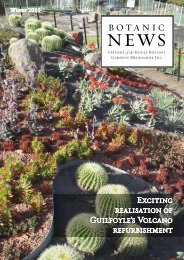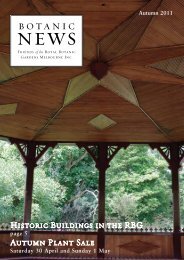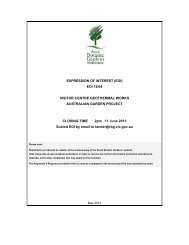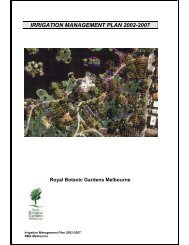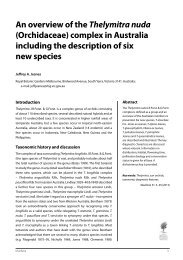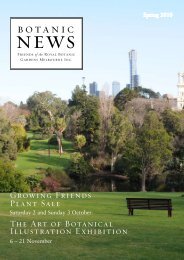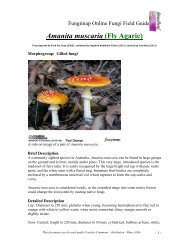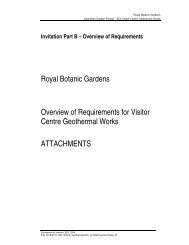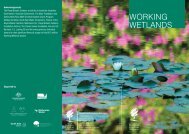Summer 2012-13(PDF - 1.32 mb) - Royal Botanic Gardens Melbourne
Summer 2012-13(PDF - 1.32 mb) - Royal Botanic Gardens Melbourne
Summer 2012-13(PDF - 1.32 mb) - Royal Botanic Gardens Melbourne
You also want an ePaper? Increase the reach of your titles
YUMPU automatically turns print PDFs into web optimized ePapers that Google loves.
esearch from the project president<br />
by Anna Syme, RBG Plant Sciences and Biodiversity<br />
Division<br />
I was honoured to receive the inaugural Helen McLellan<br />
Research Grant in 2011. I thank the Friends for their<br />
significant support, with which I have been able to<br />
undertake the project ‘Unraveling the DNA of Australian<br />
grasses: gene duplication and its implications for molecular<br />
identification and evolution.’ This research was based on a<br />
group of iconic Australian grasses, the stipoid grasses. The<br />
grant enabled the appointment of a research assistant for<br />
laboratory tasks, Stuart Gardner, and the items required for<br />
cloning and sequencing genes.<br />
The genetic material in plants includes many genes, which<br />
are sections of DNA. Sometimes genes copy themselves, and<br />
there can be two (or more) copies of the same gene existing<br />
simultaneously in a plant. This phenomenon, called gene<br />
duplication, can affect the way a plant species lives and evolves.<br />
We were looking for evidence of a particular gene duplication<br />
in stipoid grasses. Based on previous work, we suspected that<br />
these grasses may harbour a second copy of a gene that is<br />
important for plant functioning (a gene called rbcL). Plants can<br />
be identified by their genes, so finding more than one copy of a<br />
gene is important for this identification process.<br />
The results (shown in the tree on the facing page) have<br />
been intriguing. Most stipoid species that we have tested so far<br />
have at least two copies of the rbcL gene, and some species<br />
have three or even more copies. This image is a diagram of the<br />
relationships between this gene in other grass species, and the<br />
multiple gene copies found in stipoid grasses, labeled Copy 1,<br />
Copy 2 and Copy 3 in the shaded blocks.<br />
In some other grass species, gene copies are clustered<br />
together, indicating that one copy is derived from the other.<br />
However, the story is different for stipoid grasses, with each copy<br />
appearing separately. One hypothesis is that an extra copy was<br />
acquired by interbreeding between an ancestor of the stipoid<br />
grasses and a distantly-related grass cousin. This could explain<br />
why the two gene copies are found in most (possibly all) stipoid<br />
grasses, yet do not appear similar enough to each other to be<br />
a result of a duplication of the first gene copy. A similar process<br />
of interbreeding may have resulted in one stipoid grass species,<br />
Austrostipa mollis, acquiring an additional gene copy from<br />
another grass species.<br />
Having an extra copy of this gene might improve the plant’s<br />
ability to grow, which is why we might be seeing several<br />
independent cases of the duplication (or acquisition) of extra<br />
copies.<br />
An example of an Australian stipoid grass, Austrostipa vertillicata.<br />
An example of an Australian stipoid grass, Austrostipa elegantissima.<br />
14 <strong>Botanic</strong> News / summer ‘12 - ‘<strong>13</strong>




